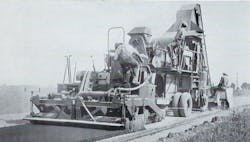Harry H. Barber and William B. Greene founded Barber-Greene Co. in Aurora, Illinois, in 1916 to manufacture standardized conveyor components that could be mass-produced by the principles developed by Henry Ford and assembled to order to meet customer needs in a vast potential market for small and light material handling applications.
Business grew quickly, and later that year they designed a bucket loader—essentially a tractor with a steeply inclined bucket conveyor and discharge chute for loading trucks from windrows and stockpiles. Business was aided by the Good Roads movement, and they adapted bucket loaders to gather and weigh aggregates in correct proportion for dry batch mixing of paving concrete. Their highly successful ditcher and trencher line followed in 1922. But in 1929, Barber-Greene entered the market where it would make the greatest impact: asphalt paving.
Berry is archivist for the Historical Construction Equipment Association (HCEA). Information is available at www.hcea. net, or by calling 419.352.5616 or e-mailing [email protected].
Blade-mixing had come into use as a rudimentary means of cheaply producing asphalt pavement. At the prompting of two men from the Chicago (Asphalt) Testing Laboratory, in what Greene called the firm’s most difficult but most successful product development, Barber developed the Travel Plant roadmixer. It combined a bucket loader with a pugmill—first as one machine, then into separate units with the loader pulled a trailer carrying the pugmill, asphalt tank, and metering equipment.
The loader was modified so as to cleanly gather windrowed aggregates on an even plane, and to blend and elevate them with minimal loss of fines to the wind. The aggregates were fed into a surge hopper, and an apron feeder forwarded them to the pugmill. The feeder was interlocked with the asphalt pump to ensure correct proportions of materials. The pugmill received asphalt from a tank beneath it, and the tank was fed by a towed trailer. The finished product was discharged down a chute with a baffle at the bottom to minimize segregation. The outfit could also produce stabilized base, and the mixer and loader could also be used by themselves.
Having been introduced to asphalt paving, Barber started addressing the need for another labor-saving machine. The Adnun paver was suitable for coarse cold-mix pavement on secondary roads, but there was no finisher on the market for denser hot mix capable of handling heavier traffic. First used in 1931, the original Barber-Greene asphalt finisher rode on forms in the manner of concrete paving equipment and laid a 20-foot slab from material fed to it by a Travel Plant that also towed it.
But Barber wasn’t through.
The advent of commercial air travel produced even more demand for high-quality asphalt pavement, and in 1934 Barber-Greene introduced its first self-propelled, free-travelling (versus form-riding) asphalt paver. Along with a much less successful paver developed by the Jaeger Machine Co., it was the first machine of its kind. This machine gave rise to the popular 879, which was produced from the late 1930s into the early 1960s, and Barber-Greene quickly became an industry leader in asphalt paving equipment.
About the Author
Tom Berry
Tom Berry is archivist for the Historical Construction Equipment Association (HCEA). Information is available at www.hcea. net, or by calling 419.352.5616 or e-mailing [email protected].
